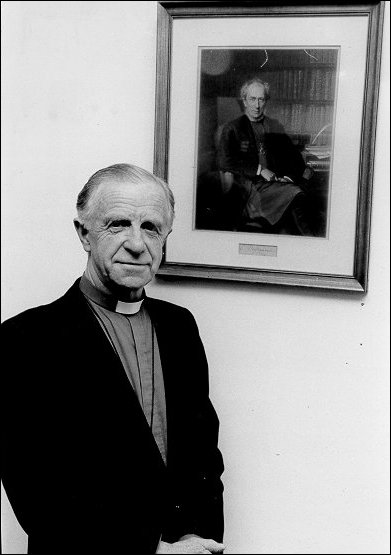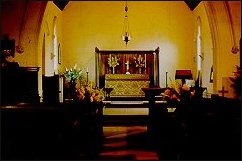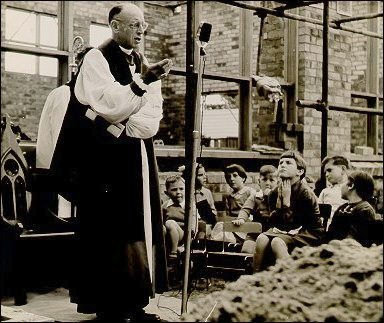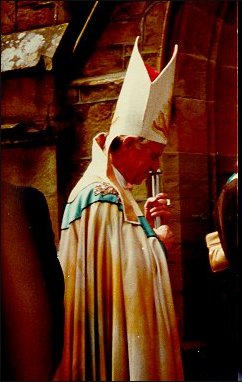Robert William Dann: Vicar

Robert Dann, Archbishop of Melbourne with etching of Bishop Perry, the first Anglican Bishop of Melbourne in background.
The appointment to St Matthew’s, Anglican Church, Cheltenham was Robert Dann’s first as a vicar. But it was not the first opportunity he had to work in a parish. As a student at Ridley Theological College and later at Trinity College, University of Melbourne he was in turn the Reader-in-Charge of the parishes of Whittlesea and Deer Park. Both of these parishes had several centres where he conducted services, managed youth clubs and supervised Sunday Schools. (Whitehead, 1999).
After his ordination as a priest in 1946 he was appointed to the position of Director of Youth and Religious Education in the Diocese of Melbourne. It was from this position that he was nominated to Cheltenham where on August 2, 1951 he was inducted as vicar by Archbishop Booth.
"When I went to the parish there were still quite a number of market gardens which had not been sub-divided. They subsequently were subdivided of course. There were a number of poultry farms still operating as well. There were no made roads throughout the new housing areas. Roads were full of ruts that went from one side to the other. It was difficult to avoid pot-holes. In 1951 we were still suffering from post-war vacancies of one sort or another. There were restrictions on use of electricity. You couldn’t connect a wired in electric stove in your own premises nor could you put in an electric hot water service so the vicarage had a foul smelling smoky kerosene hot water service. Kerosene radiators, which were a great danger and risky in terms of fires, were scattered throughout the house. Gradually these post war restrictions came to be progressively lifted. I left the parish in 1956 just at the point where experimental TV broadcasts were going on in preparation for the Olympic Games." (Whitehead 1999)
The vicarage designed by Blackmore was built in 1890 by Ireland for £623.15.0. Of weather board construction with lath and plaster walls it was seen at that time as being a handsome and commodious residence. (Polites 1992:13) On his arrival in the parish Robert Dann remembers the vicarage with its "dark wallpapered walls which presented a gloomy aspect and acres of bare wooden floors. With a bit of help from the family I set to and painted the entire house in water based ‘Calsomine’. A variety of pastel colours cheered the place up. I tacked secondhand underfelt and old carpet squares to the uneven floor." (Dann 1998:2)

Vicarage on the corner of Charman and Park Roads, 1963.
With the ever growing number of young families in the parish, the parish facilities were proving inadequate. The church had been dedicated on April 14, 1867 but with the exception of the addition of the chancel in 1905 no change had been made to the basic structure. Its capacity was about 140 worshippers. Dann said, "Later I came to think of the church as being very small but that didn’t occur to me at the time. It was a good church to function in because it was relatively small, the congregation was close to the minister and that was a help. The only problem with the church was that it soon became too small for almost every purpose." (Whitehead 1999) Similar space problems existed with the Sunday School. The answer was relatively simple,: build more accommodation, but the solution was difficult to achieve because of the lack of finance.
While money was in short supply a fund existed that had been established to create a memorial to those who served in the Second World War. Dann convinced the vestry that this money should be used to redesign and refurnish the sanctuary of the church. "The new sanctuary had four riddle posts with gold curtains surrounding the altar… there were new communion rails and new standard lights. An open carpeted space had been created by the removal of the choir to a place on the floor." This, Dann explained, was to be "a harbinger of change". (Dann 1998:5).

The redesigned sanctuary of St Matthew’s Church, 1953.
At that time it was customary for the work of the parish to be financed by Sunday collections and through use of a weekly freewill offering scheme. It was Robert Dann who convinced the parish to adopt a stewardship program, a new way of financing parish churches, which originated in the United States and was managed by the Wells Organisation. It was the second parish in Australia to adopt such a program and at a time when it was still to prove itself. "I expect the members of our vestries had never been faced with a bigger or more responsible decision. For to make a contract with Wells we had no option but to incur the substantial debt involved in meeting their fee. There was another side of this coin - the promise, but not the guarantee, of a large reward. The debate was divisive …but the decision was made for a Wells every-member canvass. … It was the American way with its theology of Christian stewardship that lay behind the extraordinary revolution that demolished our miserly habits of giving in 1954. The financial situation at St Matthew’s was transformed." (Dann 1998:10)
One of the immediate results of the stewardship campaign was the building of an educational annex to the church. On Saturday April 27 1956, the Archbishop of Melbourne, Joseph Booth, laid the foundation stone of the extensions which became a valued venue for Sunday School classes and overflow congregations at church services. After its official opening in September the vestry ruled that the annex, "not be let publicly, and that tea not be made on the premises". (Polites 1992:27).

Archbishop Booth at the laying of the foundation stone of the Annex 1956.
While the Wells program was being implemented at Cheltenham it was also running in the Beaumaris parish of St Michael’s and All Angels. Only after his appointment to Cheltenham did Dann make the "astonishing discovery" that Beaumaris was also part of his responsibilities. Consequently he quickly set about working with an existing committee to provide a place for worship and a Sunday School. By the end of September 1951, within seven weeks of his arrival in the parish, the initial service attended by twenty three people was held on an afternoon in an old double garage in Rennison Street. It was twelve months later, after the government had abolished building controls that the first stage of a master plan for the Dalgetty Road site was approved. (Dann, 1998:2)
During Robert Dann’s incumbency at St Matthew’s the sense of vocation was fostered in many lay people. Peter Wellock, a teenager and youth leader at the time, was later to become the eighteenth vicar of St Matthew’s Cheltenham, John Shepherd after study and work in England became the Dean of Perth, and Geoffrey Tisdall was ordained a priest and worked in several Melbourne parishes in addition to serving as Chaplain to Dr Rayner, Archbishop of Melbourne. There were several young theological students who assisted Dann in the parish by conducting services and working in the Sunday School. These included Michael Challen and Bob Butterss, both of whom became bishops in the church, and Lewis Firman, Alan Pattison and John Walton who became respected priests in the Melbourne diocese.
In his report to the parish in 1954, Dann was able to write, "…There are now twelve hundred families on the parish roll; this is almost double the number in 1951 … Numbers attending church have increased more than threefold … There are twice as many children in our Sunday Schools and a large band of teachers has been recruited … over 40 confirmation classes have been held … Religious instruction in State Schools … is now consistently given …" (Salt, 1954)
Much of the credit for these developments has to be given to Robert Dann whose varied life experiences equipped him admirably to face the challenge of developing a growing and demanding parish. He was born in Preston but shortly after his birth moved with his parents to Campbell’s Creek, an old mining village just outside Castlemaine. It was there that he started school. After six months at the Campbell’s Creek school the family moved to Barhum where Robert continued his education. His primary education was concluded at Dixie, in the Western District of Victoria. "It was a little rural school with one teacher. A sewing mistress came in on Wednesday afternoon. They temporally closed the school when I was twelve. To sit for my Merit exam in October I rode my bike to Mumblin State School. I passed but I didn’t go back to school again until I was twenty four and then I went to Taylor’s Night School." (Whitehead, 1999)
On leaving school at Dixie, Robert worked on the family share farm milking a hundred and fifty cows twice a day. When he was about thirteen and a half or fourteen the family moved to a small farm with about 40 cows at Struan out from Lismore. It was a struggle. Robert explained, "The depression hit and we were paying high prices for the land, the cattle and everything else. There was a great slump in prices and we had a very bad drought. After we had been there three years my dad became ill so mother and I ran the farm. I ploughed the land and planted the seed and between us we milked the cows and managed to run everything in tough times. At the end of 1933 the bank which held the mortgage foreclosed and we sold up. We came to Melbourne." (Whitehead, 1999)
.Robert was out of work for five months and then followed a succession of jobs including one selling insurance for Mutual Life and Citizens. "I collected insurance payments. I collected about forty pounds a week but we were suppose to write a lot of new business I visited just about every house from Reservoir down to Rushall trying to sell insurance. Of course people weren’t buying insurance because times were very tough and because I wasn’t writing enough new business the sack was imminent. I beat it by resigning." After a short stint with the Watkins company, an American company selling household goods and food stuffs, Robert Dann became a bread carter with Naughton’s in St George’s Road in Thornbury.. "I used to get up at four o’clock every morning. I was down in the stables at 5 o’clock getting the horse ready and then loading the cart with bread. I had to leave about twenty to six. There was a law against delivering bread before six o’clock but I didn’t ever get caught and all the other fellows went out early because there were enraged people standing at the gate or the back door expecting you to deliver fresh hot bread which they wanted to cut up for lunch.. So by half past seven I had delivered to half my customers, about eighty of them, and things eased up by then. I ran all the way until half past seven in the morning. We finished up normally about three or three thirty every day." (Whitehead 1999) It was during this time that Robert Dann resumed his association with the Anglican church.
Church had not been a dominant feature of his early years although at fourteen years of age he was confirmed by the bishop in the parish church at Lismore "We lived ten miles out of Lismore where I was prepared for confirmation by the local vicar. When I rode in for the groceries he gave me instruction in the Catechism and Dad and I drove in the buggy one night for the confirmation. After that, it was very difficult to milk the cows and get away in time for services. The following Sunday I went on my own, riding my bike to attend Communion but nobody spoke to me. That was the last time I went to church until I came to Melbourne." (Whitehead 1999)
At St Cecilia’s, West Preston Robert Dann became an active participant in the life of the parish, helping with services in the various centres, and teaching in the Sunday School, just a few steps ahead of his students. It was at St Cecilia’s that he was challenged by the Reverend Reginald McCoy to consider ordination to the ministry of the Church. (It was McCoy whom he succeeded as vicar at St Matthew’s many years later.) At an interview with Bishop Booth he was asked about his educational achievements. When Robert informed the bishop that he had left school at twelve years of age with a Merit Certificate, Booth invited him to return when he had matriculated. "I don’t think he ever expected to see me again. … I went to night school at George Taylor’s about four nights a week and got home at half past ten only to get up at 4 o’clock in the morning for the baker’s round. Early in February 1940 I had my matriculation so I went back to Bishop Booth and presented myself. He was quite pleased to see me and sent me to Ridley College to commence my formal theological studies." (Whitehead 1999) That was the beginning of forty three years of service in the Melbourne Diocese of the Anglican Church.

Archbishop Robert Dann, Anglican Archbishop of Melbourne in cope and mitre, c1980.
Dann’s farewell services at St Matthew’s Cheltenham occurred on November 11, 1956. At forty two years of age he commenced his ministry at St George’s Malvern and subsequently became vicar of St John’s Footscray and Archdeacon of Essendon. Then followed the diocesan position of Director of Evangelism and Extension. He was consecrated bishop on All Saint’s Day, November 1969 and served as an assistant bishop in the Diocese of Melbourne until his enthronement as archbishop on December 7, 1977. He retired from this position on All Saints Day 1983.
